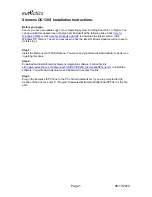
It is also a good idea to use your DNS domain name (or a subdomain, such as
ACCOUNTING.EXAMPLE.COM
). As shown below, your life as an administrator can
be much easier if you configure your Kerberos clients to locate the KDC and other
Kerberos services via DNS. To do so, it is helpful if your realm name is a subdomain
of your DNS domain name.
Unlike the DNS name space, Kerberos is not hierarchical. You cannot set up a realm
named
EXAMPLE.COM
, have two “subrealms” named
DEVELOPMENT
and
ACCOUNTING
underneath it, and expect the two subordinate realms to somehow inherit
principals from
EXAMPLE.COM
. Instead, you would have three separate realms for
which you would have to configure crossrealm authentication for users from one realm
to interact with servers or other users from another realm.
For the sake of simplicity, assume you are setting up just one realm for your entire or-
ganization. For the remainder of this section, the realm name
EXAMPLE.COM
is used
in all examples.
6.4.3 Setting Up the KDC Hardware
The first thing required to use Kerberos is a machine that acts as the key distribution
center, or KDC for short. This machine holds the entire Kerberos user database with
passwords and all information.
The KDC is the most important part of your security infrastructure—if someone breaks
into it, all user accounts and all of your infrastructure protected by Kerberos is compro-
mised. An attacker with access to the Kerberos database can impersonate any principal
in the database. Tighten security for this machine as much as possible:
1
Put the server machine into a physically secured location, such as a locked server
room to which only a very few people have access.
2
Do not run any network applications on it except the KDC. This includes servers
and clients—for example, the KDC should not import any file systems via NFS
or use DHCP to retrieve its network configuration.
3
Install a minimal system first then check the list of installed packages and remove
any unneeded packages. This includes servers, such as inetd, portmap, and cups,
as well as anything X-based. Even installing an SSH server should be considered
a potential security risk.
90
Security Guide
Содержание LINUX ENTERPRISE DESKTOP 11
Страница 1: ...SUSE Linux Enterprise Server www novell com 11 March 17 2009 Security Guide...
Страница 9: ...32 7 Managing Audit Event Records Using Keys 433 33 Useful Resources 435...
Страница 10: ......
Страница 29: ...Part I Authentication...
Страница 30: ......
Страница 55: ...Figure 4 2 YaST LDAP Server Configuration LDAP A Directory Service 41...
Страница 126: ......
Страница 127: ...Part II Local Security...
Страница 128: ......
Страница 158: ......
Страница 173: ...Part III Network Security...
Страница 174: ......
Страница 194: ......
Страница 197: ...Figure 16 2 Scenario 2 Figure 16 3 Scenario 3 Configuring VPN Server 183...
Страница 210: ......
Страница 228: ......
Страница 229: ...Part IV Confining Privileges with Novell AppArmor...
Страница 230: ......
Страница 274: ......
Страница 300: ......
Страница 328: ......
Страница 340: ......
Страница 342: ......
Страница 386: ......
Страница 387: ...Part V The Linux Audit Framework...
Страница 388: ......















































